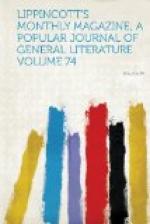Let us, then, take a stroll among them, starting from that bright centre of the foreigners’ quarter of Rome, the Piazza di Spagna. It is a brilliant January day, and, we will say, ten o’clock in the morning. In the Via Babuino and the neighboring streets, which the sun has not yet visited, the morning cold is a little sharp. Matutina parum cautos jam frigora mordent. But the magnificent flight of the great stair—there are properly eleven flights, divided by as many spacious and handsomely balustraded landing-places, each flight consisting of twelve steps, and all of white marble—with its southern exposure has almost the temperature of a hothouse. There are two or three beggars basking in the sunshine near the bottom of the steps. But our models do not consort with these. Not only are they not beggars, but they belong to a different caste and a different race. We leisurely saunter up the huge stair, pausing at each landing-place to turn and enjoy the view over the city, and the gradually rising luminous haze around the cupola of St. Peter’s, and the heights of Monte Mario clear against the brilliant blue sky. It is not till we are at the topmost flight that we come upon the objects of our ramble. There we fall in with a group of them, consisting perhaps of three or four girls, as many children, a man in the prime of life, and an aged patriarch. There is not the smallest possibility that we should pass them unobserved. They are far too remarkable and too unlike anything else around us. Even those who have no eye for the specialties of type which characterize the human countenance will not fail to be struck by the peculiarities of the costume of the group of figures before us. At the first glance the eye is caught by the quantity of bright color in their dresses. The older women wear the picturesque white, flatly-folded linen cloth on their heads which is the usual dress of the contadine women in the neighborhood of Rome. The younger have their hair ornamented with some huge filagree pin or other device of a fashion which proclaims itself to the most unskilled eye as that of some two or three hundred years ago. All have light bodices of bright blue or red stuff laced in front, and short petticoats of some equally bright color, not falling below the ankle. But the most singular portion of the costume is the universally-worn apron. It consists of a piece of very stout and coarsely-woven wool of the brightest blue, green or yellow, about twenty inches broad by thirty-three in length, across which, near the top and near the bottom, run two stripes, each about eight inches wide, of hand-worked embroidery of the strangest, old-world-looking patterns and the most brilliant colors. These things are manufactured by the peasantry of the hill-country in the neighborhood of San Germano, who grow, shear, spin, weave, dye and embroider the wool themselves. And being barbarously unsophisticated by any adulteration of cotton, and




